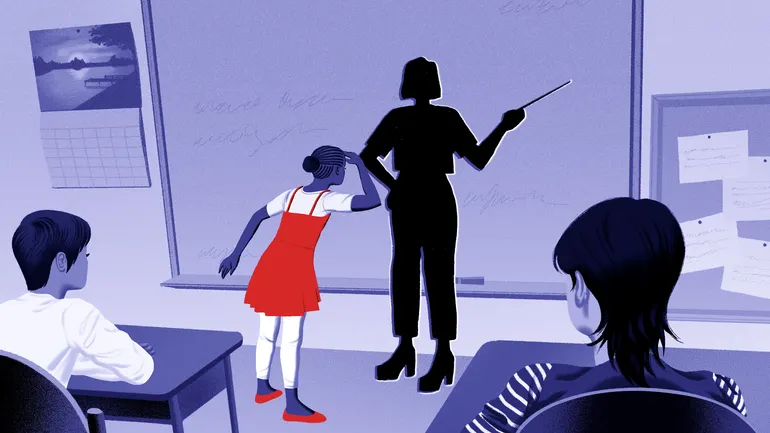Since the COVID-19 pandemic, high superintendent turnover rates have not let up — and that’s not surprising, said Wendy Birhanzel, a district leader in Colorado.
Nearly a quarter (23%) of the 500 largest districts experienced a change in their superintendency between July 1, 2024 and July 1, 2025, according to a September report by ILO Group, a national education strategy and policy firm. This turnover is up from last year’s survey results showing a 20% rate and a notable uptick from pre-pandemic averages ranging from 14% to 16%, ILO Group found.
The job of a superintendent “became a very different role” after COVID-19 shuttered school buildings nationwide in March 2020, said Birhanzel, who is in her seventh year as superintendent at Harrison School District 2 in Colorado Springs, Colorado. “Education is very politicized right now, and can be a little tricky to navigate from all the different sides of everyone in their opinions.”
Birhanzel said she mentors superintendents in Colorado and throughout the country, and she finds many saying they are “overwhelmed by the constant pressure” from their school boards, students’ families or school staff who are unhappy with the district.
While it’s difficult to pinpoint the exact cause of high superintendent turnover nationwide, one underlying reason may be the “real tension” that’s emerged in communities since the pandemic, said Julia Rafal-Baer, CEO of ILO Group and Women Leading Ed, a national network for women education leaders.
From controversial COVID-19 policies to rules on screens and devices and growing district enrollment and financial challenges, she said, things have “come to a head” and landed on district leaders.
Moreover, the superintendency is one of the most influential roles in K-12 as it directly impacts high-level strategy as well as the teacher workforce and their working conditions, Rafal-Baer said.
“And yet we are paying less attention to the fact that the churn [in the superintendency] that we thought would be temporary is our new normal, and it’s straining our districts when students need that kind of steady, effective leadership,” she said.
Many districts typically outline a five-year strategic plan with set missions and goals that then acts as a blueprint for the system’s needs, said Dennis Willingham, superintendent at Walker County School District in Jasper, Alabama.
Superintendent turnover is concerning because that means district leaders are likely not staying long enough to execute those five-year strategies effectively, he said.
Then when a new superintendent steps into the role, they may want to take the district into a totally different direction, Willingham said, which can be discouraging and confusing to school communities.
Birhanzel also noted that superintendent turnover can lead to “a domino effect” with more district turnover in other roles like administrators, principals, teachers and even bus drivers. “It goes deeper than just one position,” she said.
Despite the high turnover, just one-third of superintendent roles are held by women, according to ILO Group data. Even with year-over-year improvement, parity between men and women won’t be reached until 2054 if the current pace continues, the firm said.
What can be done?
Willingham and Birhanzel agreed that much of the pressure put on superintendents stems from disagreements or tension with their school boards. While both superintendents reported good relationships with their boards, they said they recognized that the positive dynamic they experience can be rare.
Pressure from strained school board relationships “takes away the focus” from the school system and “also the joy of being a superintendent,” Willingham said.
Both superintendents emphasized that board support is key to retaining district leaders. If the superintendent and board are unified, it’s easier to move forward with strategic plans and focus on students and staff, Willingham said.
Birhanzel cautioned that superintendents should consider that relationship before accepting the job. It’s important to go where the board “aligns with what you believe in and your why,” she said. If that compatibility isn’t there, she added, “then that won’t be good for anyone in the system.”
A shift is also needed in society’s mindset about the value of a superintendent, Birhanzel said. Superintendent turnover may be common because communities and school boards associate firing these leaders with a way to make a change. But if that’s a frequent move, she said, it will be difficult for the school system to be successful.
Overall, Birhanzel said, a cultural change is needed to get rid of the idea that firing a superintendent is the answer to a problem — instead of working together to find a solution. “In way too many cases, do we see politics drive decisions of who leads school districts instead of [who is] the best leader for students?”
The role of superintendent can be isolating, Birhanzel acknowledged. That’s why it’s important to foster more networks and support systems for those in the role. There’s a high need for mentorship, especially for prospective women superintendents, Birhanzel added.
In September, Women Leading Ed released guidance outlining ways districts can go beyond mentorships by intentionally coaching and sponsoring future leaders, particularly women.
While efforts are underway to address the underrepresentation of women in district leadership, the issue persists, leading Birhanzel to ask, “How long is it going to take to change these numbers?”





